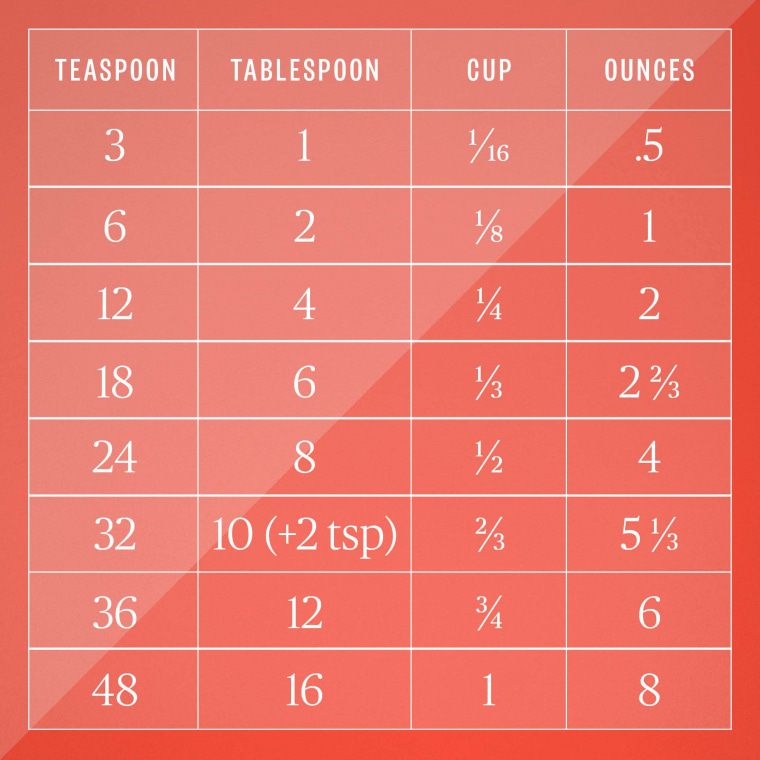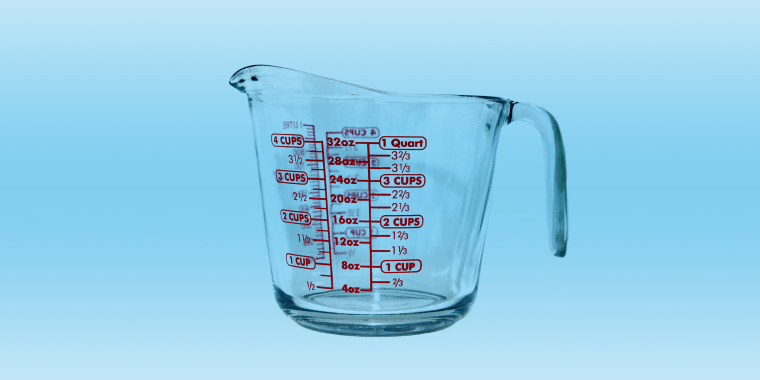Measurement conversions in the kitchen don’t seem like a big deal — until you are busy baking and trying to do quick math in your head as you double or triple a recipe.
Memorizing how many teaspoons are in a tablespoon or how many cups are in a gallon can speed up your kitchen prep and make you a more confident cook. Once we've covered the basic conversions, we'll offer pointers and answer questions, like what’s the difference between dry and liquid measurements?

Food measurement conversions
Here are the most common measurement conversions that will help you divide or multiply your recipe servings. Learning how many sticks of butter equal one cup, or how many quarts are in a gallon, is enough to be a game-changer for your cooking and baking efficiency.
How many teaspoons in a tablespoon?
There are three teaspoons in one tablespoon.
How many tablespoons in a cup?
1/8 cup = 2 tablespoons
1/4 cup = 4 tablespoons
1/2 cup = 8 tablespoons
3/4 cup = 12 tablespoons
1 cup = 16 tablespoons
How many ounces in a cup?
There are eight fluid ounces in one cup.
How many cups in a pint?
There are two cups in one pint, or 16 fluid ounces.
How many cups in a quart?
There are four cups in one quart, or 32 fluid ounces.
How many pints in a quart?
There are two pints in one quart.
How many cups in a gallon?
There are 16 cups in one gallon, or 128 fluid ounces.
How many quarts in a gallon?
There are four quarts in one gallon.
Butter conversions
Two sticks of butter are the equivalent of one cup or eight ounces.
How many grams in an ounce?
There are 28 grams in one ounce.
How many ounces in a pound?
There are 16 ounces in one pound.
How many milliliters in an ounce?
There are 30 milliliters in one fluid ounce.
How many milliliters in a cup?
There are 237 milliliters in one cup.
How many milliliters in a pint?
There are 473 milliliters in one pint.
How many milliliters in a quart?
There is .95 liters in one quart.
How many milliliters in a gallon?
There are 3.8 liters in one gallon.
Measuring pointers
Make sure you have the right tools
Have a set of measuring teaspoons, a set of measuring cups for dry ingredients and liquid measuring cups ranging from a one-cup to four-cup capacity. While it’s not absolutely necessary to own, a food scale is useful to have, as it allows you to make recipes that list ingredients by weight. This is particularly useful for baking, which often demands exact measurements.
Level off your dry ingredients for the right measurement
Unless the recipe calls for “a heaping tablespoon” or “a generous cup,” you’ll want to level off the dry ingredients you’re measuring. That just means taking the flat side of a butter knife and running it across the top of the full cup or spoon, so any excess is sloughed off.
Use the right cups for dry and wet ingredients
At some point, most home cooks have dumped flour into a liquid measuring cup or measured milk in a dry measuring cup. Some recipes are forgiving enough that you can get away with it. But others, especially if you are baking, can be completely ruined. Technically dry and liquid measuring cups measure the same, but it’s not a perfect science. A liquid measuring cup doesn’t allow you to level off your dry ingredients, so it’s really hard to measure exactly. And measuring wet ingredients in a dry cup is difficult, since measuring right to the rim can lead to spillage.
What's the difference between an ounce and a fluid ounce?
If a recipe lists dry ingredients in ounces, you’ll need a kitchen scale to measure it. But if a recipe lists a wet ingredient in ounces, you can measure it in a liquid measuring cup. Ounces are measured by weight, and fluid ounces are measured by volume. While eight ounces of water can be converted to one cup of water, the same can’t be done for eight ounces of sugar -— make sense?
How to measure baking ingredients properly
What exactly does it mean when a recipe calls for packed light brown sugar? As opposed to a “scoop and shake” method, packed brown sugar means that you need to use the measuring cup to scoop the brown sugar and then use your hand to pack it tightly before adding it to the mixing bowl. If a recipe calls for one cup of sifted flour, that means you need to pre-sift the flour before measuring it.
